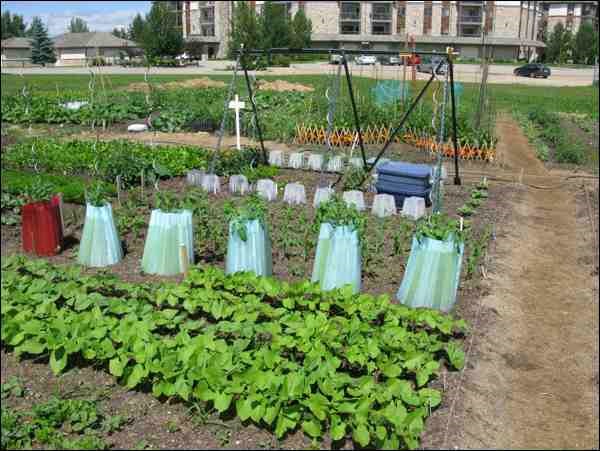The popularity of community gardening keeps growing due to a yearning for fresh vegetables or a desire to limit the use of synthetic chemicals in food production. Also, there are people who, because of a change in their circumstances (e.g. a move to the city from the farm where acre-sized plots may have been the norm; a downsizing from house to condo where personal garden space is rare; or young couples and families who want to lower their food bill and teach their children life lessons), community gardening represents an attractive option.
There are two types of community gardens. One type is a space where several gardeners have individual but adjoining plots, growing food for themselves. Plot size varies but is typically 150 to 200 sq. ft. Many community gardens are autonomous: as a group developing and agreeing to a basic constitution, code of conduct and, of course, rules. A committee organizes events, schedules group work sessions, manages day-to-day operations, allocates space and deals with conflict. In the community garden I belong to, there are actually few rules. One of the big ones is no use of synthetic fertilizer or pesticides is allowed. Modest fees ($40 to $60) cover the cost of materials and outside services (e.g. rototilling).
The other type of community garden is commonly managed by a non-profit charitable organization to grow food to supplement food banks, school lunch programs, lower income families and the like. The entire space is managed as a single large garden, relying on volunteers to organize, plan, seed, weed, water and harvest. This type is also known as a "communal garden."
Between these dichotomies is common ground. Individual gardeners can "grow a row," donating a portion of their produce. Or individual plots are gardened communally with the intent of donating all the food off those plots. Some community gardens even allow non-members in the immediate neighbourhood to harvest a "reasonable" amount for themselves - a truly generous gesture, one that I heartily support.
The deadline to book a plot in most gardens falls at the end of February, so don't dawdle. In Saskatoon, CHEP [www.chep.org; an organization concerned with improving access to good food and promoting food security] provides support to over 25 community gardens across the city. Contact CHEP's community garden co-ordinator to get a list of gardens and individual garden contact information [Gord Androsoff; 306-655-575 ext. 229; [email protected]]. The City of Saskatoon manages a separate community garden space [306-975-3300; [email protected]]. In Regina, there are several community garden organizations: GrowRegina [www.growregina.ca; [email protected]], Al Richie Community Association [http://nonprofits.accesscomm.ca/alritchie/; 306-522-3930; [email protected]]; Carmichael's Outreach Community Garden [a charitable communal garden; 306-753-9952; [email protected]]; Cathedral Area Community Garden [www.cathedralvillage.org; 306-569-8755; [email protected]]; North Central Community Gardens [a charitable communal garden; www.nccaregina.ca/community_garden; 306-791-9888; [email protected]]; Northwest Community Garden [306-924-4314; [email protected]]; and South Zone Community Garden [www.szcomgardens.com; 306-565-1312; [email protected]]. In Moose Jaw, the YARA community garden is managed by Hunger in Moose Jaw [www.mjcommunitygarden.blogspot.ca; 306-692-1916; [email protected]].
I'm sure I've missed several organizations in the cities I've listed as well as throughout Saskatchewan. Besides consulting Google, your local community association, library, school, church, RM or town office may be able to point you to the closest community garden.
If there isn't a nearby community garden, you have other options. You can partner with someone with an "unused" backyard, someone who can't or doesn't have the time to garden themselves. A share of your bounty is usually payment enough. In Saskatoon, CHEP helps link gardeners with homeowners. If you're more community minded, consider creating a new community garden. There is help out there to get underway (eg. existing community garden are a great source of advice). And there may still be time to register for the CHEP's Community Garden Conference (see above for contact details) Feb. 8 in Saskatoon. It'll be a chance to learn about some of the challenges and best practices for creating a community garden as well as meeting others already involved in operating one.
- This column is provided courtesy of the Saskatchewan Perennial Society (www.saskperennial.ca; [email protected]).




